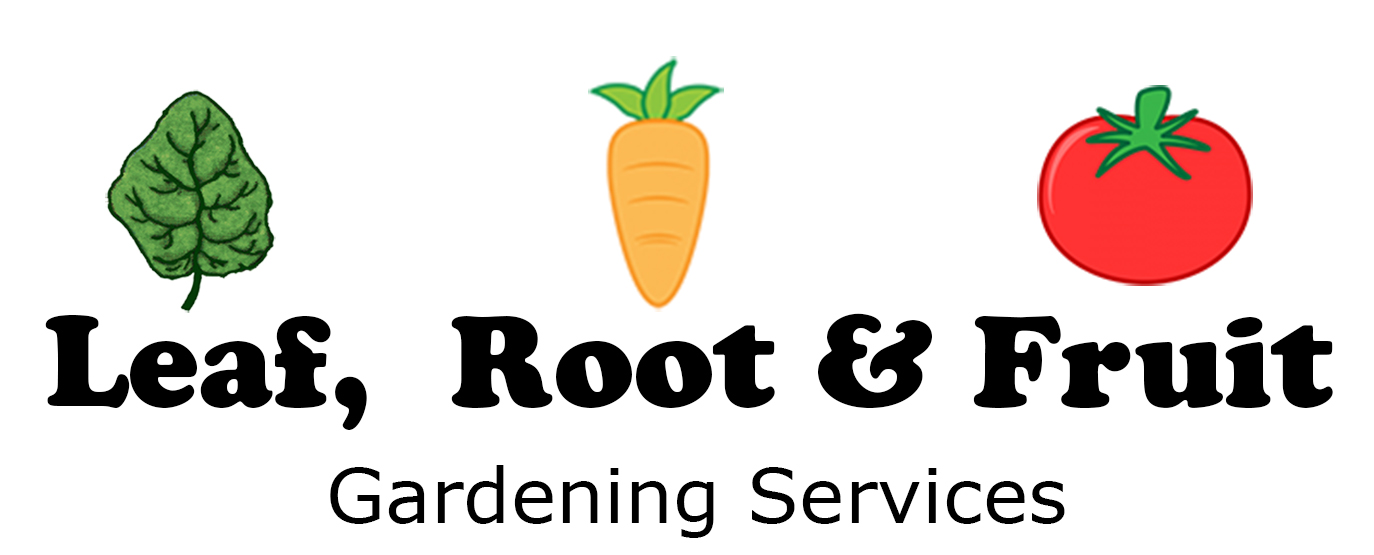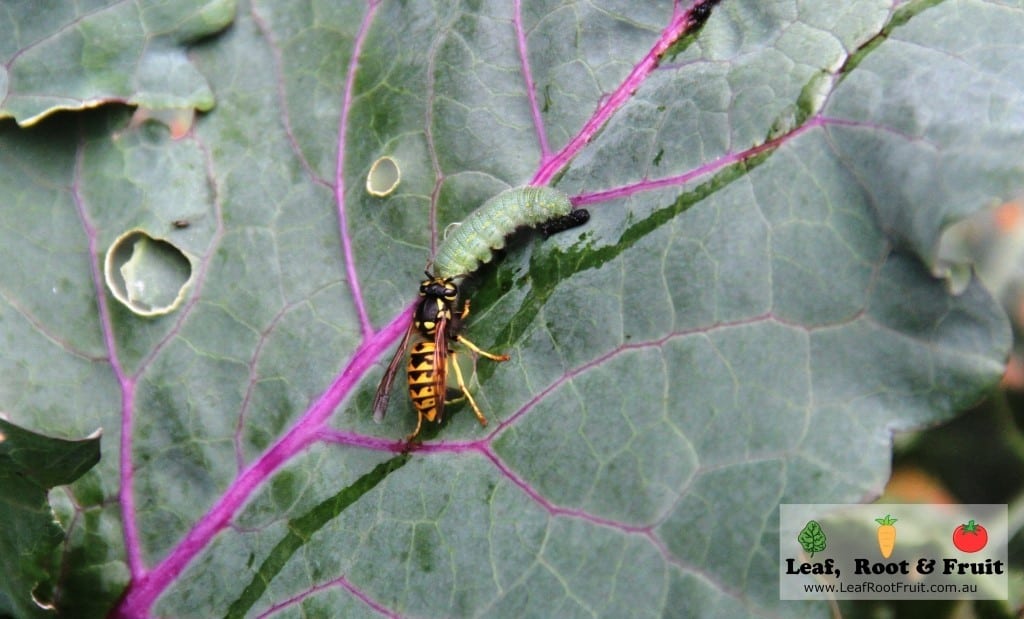Last week I posted about controlling the damage caused by White Cabbage Moths in the garden. Since then, I’ve gone from removing ten to twenty caterpillars a day from the garden, to now only finding one or two. However, this rapid decrease in numbers has not been entirely due to the usual Predatory Wasps. This week I’ve noticed many European Wasps (Vespula germanica) flying around the garden bed and crawling through the leaves of the Brassicas. The wasps are actively searching out the caterpillars, chewing them into bite sized pieces and flying them back to their nests. Presumably, they are hoarding protein to survive the upcoming Winter. I’ve managed to video some of the action, please excuse my shaky camera skills – European Wasps are difficult to keep up with!
In Australia, European Wasps are often seen in quite a negative light. Since their introduction to the Australian mainland, in 1977, we have become fearful of leaving soft drink cans unattended for fear of swallowing one. Despite early reports labeling it as a ‘Killer Wasp’, no human deaths have been recorded in Australia. The European Wasp is here to stay and we’re learning to live with this “pest”. Given my recent discovery in the garden, I’m wondering if European Wasps are starting to change from a “problem” to a “solution”?
Can the European Wasp Also Help With Controlling Fruit Fly?
European wasps clean up fallen fruit in orchards and under backyard fruit trees. The wasps only seem eat fruit with damaged skin and I haven’t seen them touch intact fruit. The fallen fruit can provide an ideal breeding ground for Queensland Fruit Fly (Bactrocera tryoni). This fruit fly can cause significant problems in the horticulture industry and for home gardeners alike. The Queensland Fruit Fly is slowly making its way to Melbourne, it is already in Shepparton. Perhaps, European Wasps will help keep Queensland Fruit Fly populations under control too?
What do you think about European Wasps? Are they the bane of your outdoor social gatherings? Or do you also find them helpful in the garden?






Hi, l just found your blog. I’m l keen gardener in the SE Suburbs. I lived here and on the mornington penisula for all of my life for the exception of the past 3 in Bendigo. In central Victoria there are so many different types of wasps it was mind boggling but not once did l have problems with catapillars but earwigs wow thats another story.
I think you shed a new light on this angry little bugger for me. I’ve seen them hunt down flies often in summer and generally if you don’t go near their nests they are not to hard to live with. I am becoming more of a living with problems than killing them sort of person. Deflection crops and smart planting are the ways to go. Thanx for a great read
Steve
Hi Steve,
Thanks for your comments. I’m glad it provoked an alternative viewpoint for you! I’m a big advocate for “do nothing gardening” and sounds like you’re starting to garden with a similar attitude! Please keep us updated on your garden’s progress!
Good Luck and Happy Gardening!
Duncan
This is part of a proposal I am looking at starting.
“In many parts of Australia, the ecology has changed due to the introduction of feral animals and introduced fauna that has had a disastrous effect on our ecosystem(Burgess, Johnston, Bowman, & Whitehead, 2005). European Wasps are such a small insect yet they are one feral species that are having a disastrous effect on our native flora and fauna as they destroy all insect life in their territory and this can be an area of upto 900m from their nest. Many native birds are also territorial and if the birds live in the area of the European Wasp, the destruction of the insects means starvation of the birds and easier pray for predatory animals. For us and our environment the worst food source for the European Wasp is the bee. The European Wasp not only feed on the Bees, they invade their hive and eat their larvae, Queen and the honey. By killing off the bees and other pollinating insects interrupts the pollination cycle of many native fauna species and this in turn has a disastrous effect on the whole ecosystem in and around their territory(Dennis, 2016).”
Now imagine my surprise that you are promoting them as a good thing without even bothering to look at the damage they are doing outside your gardens. Imaging how well your gardens will grow without bees to pollinate.
I hope you remove this and promote the damage they do
Burgess, C. P., Johnston, F. H., Bowman, D. M. J. S., & Whitehead, P. J. (2005). Healthy country: healthy people? Exploring the health benefits of Indigenous natural resource management.(Indigenous Health)(Author Abstract). Australian and New Zealand journal of public health, 29(2), 117.
Dennis, K. (2016). Invasive Species Summary and Recommenation. http://www.parliament.vic.gov.au/images/stories/committees/enrc/Invasive_Animals_on_Crown_land/11D._2016.07.27_Mr_Dennis_Keith_Attachment_4.pdf.
Hi, Thanks for the feedback. I’m not saying that European wasps should be nurtured or protected. I do understand the negative impacts that they have on the greater environment. What I am saying is that they are here, they are going to be next to impossible to eradicate, but that they are also having some (minor) benefits in the garden… In Permaculture we look to turn problems into solutions, that’s all I’m doing.
In your opening sentence you refer to a proposal that you’re looking at starting. I’d like to know more, can you explain a bit about it please?
I just watched a European wasp scan a kale plant for caterpillars, sting a caterpillar that was about twenty mm long and fly off with it. A cabbage white caterpillar. A Sunday afternoon in December.
Hi Catherine,
What a great observation! We experienced much lower numbers of Euro Wasps in central Victoria this summer, but I noticed numbers were still high in Melbourne.
Thanks for sharing
Duncan
Very interesting to read. I have noticed over the last few days wasps hanging around my corn. In particular the European wasp. Friend or foe? I reckon it’s both. Even though they are awful horrible things they may well be having a good gander for whatever they need to eat on. There are also paper wasps hanging around too. I’m a gardener that does very little and expects results from doing very little. My composting and my soil are the only things I work on. So in the end whatever lands on my corn 🌽 can or if it lands on my lettuce or celery or cucumber or carrots or tomatoes they can. If a predator ( European wasp) decides to hang around so be it. Look I’m with you it’s here to stay and if it’s useful so be it. although we can minimise its damage through nest destruction.
Hi Shane, glad we share similar gardening philosophies. The European wasp could be chasing wither protein in the form of prey or carbohydrate in the form of sugary exudates from the corn plants. It could be an early sign of an aphid infestation. Either way, I personally wouldn’t be doing much, other than watching the situation unfold as you’ll still likely get to enjoy your delicious corn in the end!
Good Luck & Happy Gardening